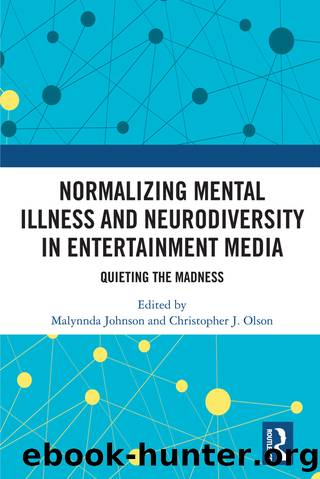Normalizing Mental Illness and Neurodiversity in Entertainment Media by Malynnda Johnson Christopher J. Olson

Author:Malynnda Johnson, Christopher J. Olson [Malynnda Johnson, Christopher J. Olson]
Language: eng
Format: epub
ISBN: 9781000377408
Barnesnoble:
Publisher: Taylor & Francis
Published: 2021-04-19T00:00:00+00:00
References
Berger, P. (2014). Redeeming laughter: The comic dimension of human experience. Walter de Gruyter.
Billig, M. (2005). Laughter and ridicule: Towards a social critique of humour. SAGE.
Brayton, S. (2017). The âmadnessâ of market logic: Mental illness and late capitalism in âThe Doubleâ and âNightcrawler.â Communication and Critical/Cultural Studies, 14(1), 66â82. https://doi.org/10.1080/14791420.2016.1216576
Brône, G. (2008). Hyper- and misunderstanding in interactional humor. Journal of Pragmatics, 40(12), 2027â2061. https://doi.org/10.1016/j.pragma.2008.04.011
Bryman, A. (2016). Social research methods (5th ed.). Oxford University Press.
Chang, Y.-T., Ku, L.-C., & Chen, H.-C. (2018). Sex differences in humor processing: An event-related potential study. Brain and Cognition, 120, 34â42. https://doi.org/10.1016/j.bandc.2017.11.002
Coulthard, L., Horeck, T., Klinger, B., & McHugh, K. (2018). Broken bodies/inquiring minds: Women in contemporary transnational TV crime drama. Television & New Media, 19(6), 507â514. https://doi.org/10.1177/1527476418768001
Critchley, S. (2002). On humor. Routledge.
Davis, M. (1993). Whatâs so funny? The comic conception of culture and society. University of Chicago Press.
Denham-Vaughan, S. (2010). The liminal space and twelve action practices for gracious living. British Gestalt Journal, 19(2), 34â45.
Giddens, A., & Sutton, P. W. (2017). Sociology (8th ed.). Polity Press.
Gray, E. (2014). In/between places: Connection and isolation in The Bridge. Aeternum: The Journal of Contemporary Gothic Studies, 1(1), 73â85.
Jaarsma, P., & Welin, S. (2012). Autism as a natural variation: Reflections on the claims of the neurodiversity movement. Health Care Analysis, 20, 20â30. https://doi.org/10.1007/s10728-011-0169-9
Kozintsev, A. (2010). The mirror of laughter. Transaction Publishers.
Kuipers, G. (2008). The sociology of humor. In V. Raskin (Ed.), The primer of humor research (pp. 361â398). Mouton de Gruyter.
Larkin-Galinanes, C. (2017). An overview of humor theory. In S. Attardo (Ed.), The Rout-ledge handbook of language and humor (pp. 4â16). Routledge.
Martin, R. A. (2006). The psychology of humor: An integrative approach. Elsevier.
McCabe, J. (2015). Disconnected heroines, icy intelligence: Reframing feminism (s) and feminist identities at the borders involving the isolated female TV detective in Scandinavian Noir. In L. Mulvey & A. Backman Rogers (Eds.), Feminisms (pp. 29â43). Amsterdam University Press.
McHugh, K. (2018). The female detective, neurodiversity, and felt knowledge in Engrenages and Bron/Broen. Television & News Media, 19(6), 535â552. https://doi.org/10.1177/1527476418767995
McHugh, L., & Stewart, I. (2012). The self and perspective taking: Contributions and applications from modern behavioral science. New Harbinger Publications.
McMahon-Coleman, K., & Weaver, R. (2020). Mental health disorders on television: Representation versus reality. McFarland & Company, Inc.
Mulkay, M. (1988). On humor: Its nature and its place in modern society. Blackwell.
Nilsen, D. L. F., & Nilsen, A. P. (2019). The language of humor: An introduction. Cambridge University Press.
Raymaker, D. M. et al. (2020). âHaving all of your internal resources exhausted beyond measure and being left with no clean-up crewâ: Defining autistic burnout. Autism in Adulthood, 2(2), 132â142. https://doi.org/10.1089/aut.2019.0079
Rohr, R. (1999). Everything belongs. The Crossroad Publishing Company.
Schwartz, C., & Kaplan, A. E. (2018). The female detective as the child who needs to know: Saga Norén as an example of potent yet dysfunctional female detectives in contemporary Nordic Noir. European Journal of Scandinavian Studies, 2(48), 213â230. https://doi.org/10.1515/ejss-2018-0017
Seago, K. (2018). âPhilip Marlowe in drag?â â The construct of the hard-boiled detective in feminist appropriation and translation. Ars Aeterna, 9(2), 39â52. https://doi.org/10.1515/aa-2017-0008
Stegger Gemzøe, L.
Download
This site does not store any files on its server. We only index and link to content provided by other sites. Please contact the content providers to delete copyright contents if any and email us, we'll remove relevant links or contents immediately.
Phoenicians among Others: Why Migrants Mattered in the Ancient Mediterranean by Denise Demetriou(584)
Verus Israel: Study of the Relations Between Christians and Jews in the Roman Empire, AD 135-425 by Marcel Simon(581)
Caesar Rules: The Emperor in the Changing Roman World (c. 50 BC â AD 565) by Olivier Hekster(565)
american english file 1 student book 3rd edition by Unknown(551)
Basic japanese A grammar and workbook by Unknown(514)
Europe, Strategy and Armed Forces by Sven Biscop Jo Coelmont(509)
Banned in the U.S.A. : A Reference Guide to Book Censorship in Schools and Public Libraries by Herbert N. Foerstel(474)
Give Me Liberty, Seventh Edition by Foner Eric & DuVal Kathleen & McGirr Lisa(472)
The Roman World 44 BC-AD 180 by Martin Goodman(466)
Reading Colonial Japan by Mason Michele;Lee Helen;(461)
DS001-THE MAN OF BRONZE by J.R.A(455)
The Dangerous Life and Ideas of Diogenes the Cynic by Jean-Manuel Roubineau(446)
Introducing Christian Ethics by Samuel Wells and Ben Quash with Rebekah Eklund(443)
Imperial Rome AD 193 - 284 by Ando Clifford(438)
The Oxford History of World War II by Richard Overy(437)
Literary Mathematics by Michael Gavin;(402)
Catiline by Henrik Ibsen--Delphi Classics (Illustrated) by Henrik Ibsen(397)
Language Hacking Mandarin by Benny Lewis & Dr. Licheng Gu(392)
How to Reach the 9.0 in IELTS Academic Reading by IELTS Medical(364)
